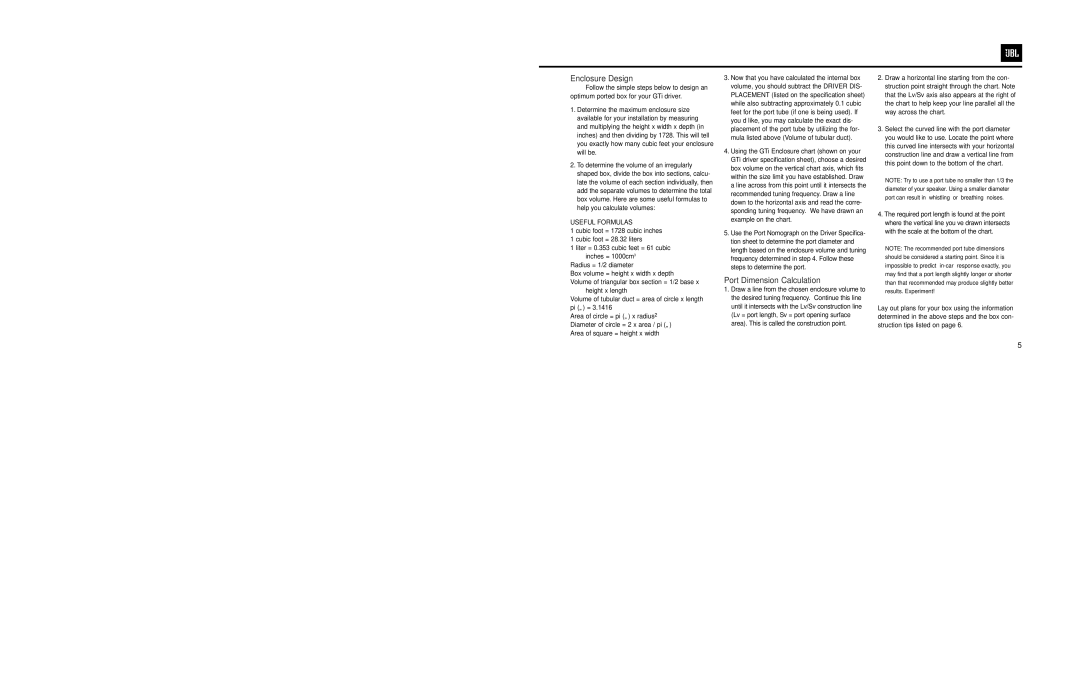
Enclosure Design
Follow the simple steps below to design an optimum ported box for your GTi driver.
1.Determine the maximum enclosure size available for your installation by measuring and multiplying the height x width x depth (in inches) and then dividing by 1728. This will tell you exactly how many cubic feet your enclosure will be.
2.To determine the volume of an irregularly shaped box, divide the box into sections, calcu- late the volume of each section individually, then add the separate volumes to determine the total box volume. Here are some useful formulas to help you calculate volumes:
USEFUL FORMULAS
1 cubic foot = 1728 cubic inches
1 cubic foot = 28.32 liters
1 liter = 0.353 cubic feet = 61 cubic inches = 1000cm3
Radius = 1/2 diameter
Box volume = height x width x depth
Volume of triangular box section = 1/2 base x height x length
Volume of tubular duct = area of circle x length pi (π) = 3.1416
Area of circle = pi (π) x radius2 Diameter of circle = 2 x area / pi (π) Area of square = height x width
3.Now that you have calculated the internal box volume, you should subtract the DRIVER DIS- PLACEMENT (listed on the specification sheet) while also subtracting approximately 0.1 cubic feet for the port tube (if one is being used). If you’d like, you may calculate the exact dis- placement of the port tube by utilizing the for- mula listed above (Volume of tubular duct).
4.Using the GTi Enclosure chart (shown on your GTi driver specification sheet), choose a desired box volume on the vertical chart axis, which fits within the size limit you have established. Draw a line across from this point until it intersects the recommended tuning frequency. Draw a line down to the horizontal axis and read the corre- sponding tuning frequency. We have drawn an example on the chart.
5.Use the Port Nomograph on the Driver Specifica- tion sheet to determine the port diameter and length based on the enclosure volume and tuning frequency determined in step 4. Follow these steps to determine the port.
Port Dimension Calculation
1.Draw a line from the chosen enclosure volume to the desired tuning frequency. Continue this line until it intersects with the Lv/Sv construction line (Lv = port length, Sv = port opening surface area). This is called the construction point.
2.Draw a horizontal line starting from the con- struction point straight through the chart. Note that the Lv/Sv axis also appears at the right of the chart to help keep your line parallel all the way across the chart.
3.Select the curved line with the port diameter you would like to use. Locate the point where this curved line intersects with your horizontal construction line and draw a vertical line from this point down to the bottom of the chart.
NOTE: Try to use a port tube no smaller than 1/3 the diameter of your speaker. Using a smaller diameter port can result in “whistling” or “breathing” noises.
4.The required port length is found at the point where the vertical line you’ve drawn intersects with the scale at the bottom of the chart.
NOTE: The recommended port tube dimensions should be considered a starting point. Since it is impossible to predict
Lay out plans for your box using the information determined in the above steps and the box con- struction tips listed on page 6.
5
